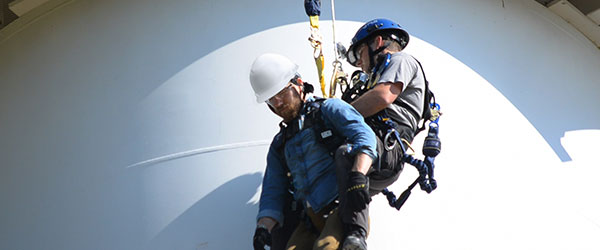
Harness Suspension Trauma
When asked about the advantages of using safety nets as a primary means of fall arrest, we point out that one of the key advantages that this type of system has is that safety nets provide a passive/collective means of fall arrest, which means that once the nets are installed, the fall protection system being employed does not rely on any further action being taken by the person at risk of falling to arrest any possible fall. This primarily relates to the use of harnesses etc, where there is an obligation on the worker to ensure that the harness is securely fastened to a suitable safe anchor point at all times.
There are times when it is simply not possible to install safety nets, and harnesses are then used as a perfectly safe means of providing fall arrest protection for the workforce.
Indeed, our riggers themselves are extremely familiar with the use of harnesses as they often use elevated work platforms (EWP) to install nets, and the use of fall arrest harnesses whilst working from an EWP is compulsory. Harnesses certainly have a very important part to play in preventing injuries as a result of falls from height.
However, while it seems that having a fall protection harness arrest your fall is nothing but good, there’s a not-so-obvious hazard that many people aren’t aware of - fall protection harness suspension syndrome, and it can lead to rapid death (even after the harness might have just saved a life by stopping a fall). Harness suspension syndrome is known by some other names as well, including harness suspension trauma, simply suspension trauma, or orthostatic intolerance.
If a person has been suspended from a fall protection harness for too long (and this varies from person to person), the harness can cut off blood flow to parts of the body. In particular, blood flow to the person’s head may be significantly reduced .Death from suspension trauma is sometimes known as “harness-induced pathology.”
In some cases, suspension trauma can occur after only 2-3 minutes. In others, it may take 15-20 minutes. In still other cases, a person may be suspended from a harness for an hour or more without experiencing suspension trauma. So it is recognised that it’s unpredictable, variable, and can happen very quickly.
It is vitally important that anyone working with harnesses is aware of the steps to take to avoid incidence of harness trauma. If there is a fall, and if someone is suspended from a fall protection harness, they need to be rescued, placed in safe position and the harness removed as quickly as possible. A site specific rescue plan must be in place to ensure measures are taken at the earliest possible time to minimise likelihood and impact of, harness suspension trauma.
The following factors contribute to the onset of suspension trauma:
- Injuries during the fall
- An inability to move the legs while in the harness
- Hypothermia
- Shock
- Cardiovascular disease
- Respiratory disorder
- Blood loss
Prevention:
So what are key factors to be considered in preventing harness suspension trauma? What do your employees need to know before they start working at height?
First and foremost, it is important that there is a good rescue plan in place and that all workers are well trained. It is often a matter of minutes and seconds, that are crucial, and can save a person’s life.
The rescue “team” must always be present and use the correct equipment. Working alone at height is not a good idea. At Safety Nets NZ we have a “No Lone Worker” policy which means that our teams always work in pairs.
The next step is to choose a suitable harness. Harnesses with integrated relief straps are preferred. These straps are used as a support for the victim to stay upright and therefore helps to prevent the effects of suspension trauma after a fall by allowing victim to stand up in their harness.
The sooner the victim is brought to ground level, the better. Everything thing possible should be done to bring the victim to ground at the earliest possible time.
Even After the victim has been rescued it's not over.
The blood that has accumulated in the legs is of poor quality. It is low in oxygen and saturated with CO2. If the victim were to be placed in a lying position, the poor quality blood will flow back to the brain all at once. This is what is known as reflow syndrome.
To prevent this, the victim should be placed in a sitting position with the trunk upright and the legs bent at the knees (W-position). This allows a small amount of blood to go to the brain, and the greater part remains in the legs.
If the person is unconscious, they should remain in an upright position, at all times making sure that the airways are kept clear.
If however it is necessary to resuscitate the victim, it will be necessary to stretch out the victim on the ground. Without a heartbeat, the blood will remain where it is. In any case, following a rescue, you must always call for professional help.
Conclusion:
- Suspension trauma is extremely complex. Both medically and practically. Even though it is rare, it is very important to include it in your risk and rescue plans, and to follow a preventive policy.
- Irrespective of whether you're working at heights of 3, 10 or 100 metres, you must always encourage your colleagues to work safely at height.
- Correct use of harnesses, belts, ropes and a rescue system, should all be part of your rescue plan.
- Regular training and awareness is very important as well.
Until next time……
14 2021
